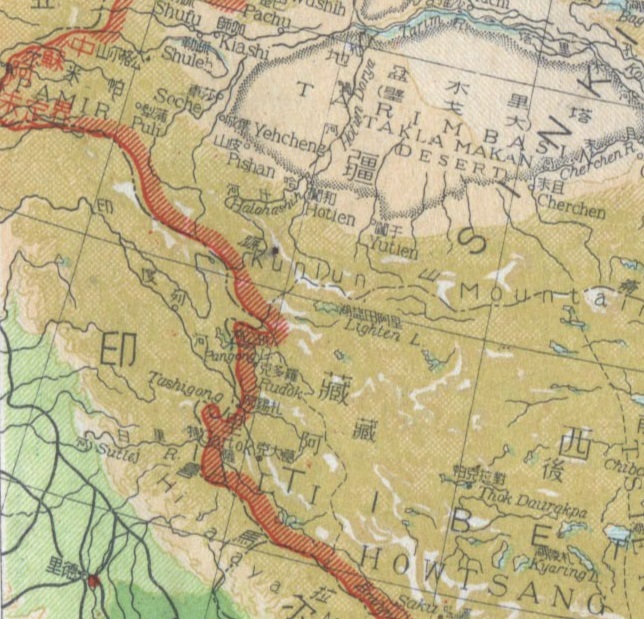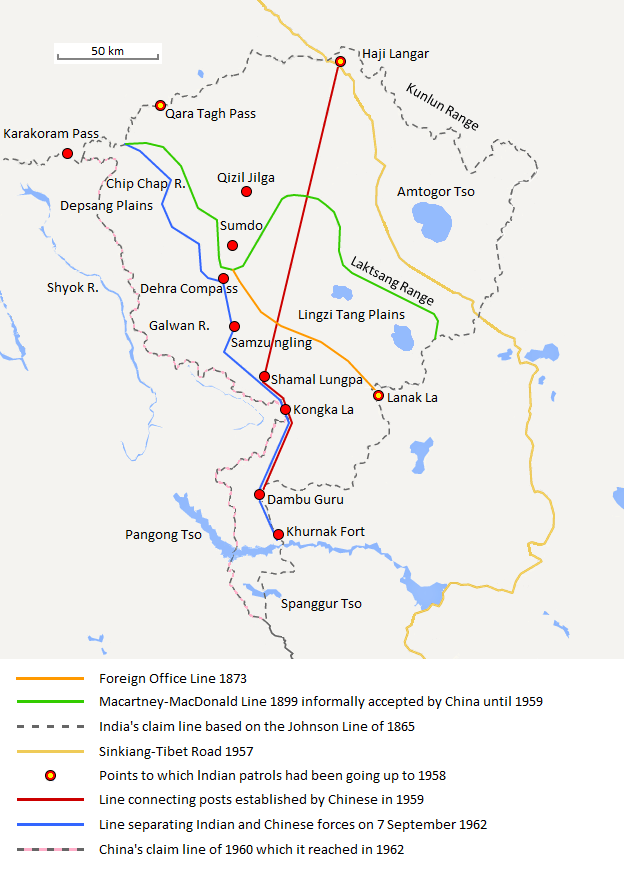|
Galwan Valley Clashes
The Galwan River flows from the disputed Aksai Chin area administered by China to the Union Territory of Ladakh, India. It originates near the caravan camping ground of Samzungling on the eastern side of the Karakoram range and flows west to join the Shyok River. The point of confluence is 102 km south of Daulat Beg Oldi. Shyok River itself is a tributary of the Indus River, making Galwan a part of the Indus River system. The narrow valley of the Galwan River as it flows through the Karakoram mountains has been a flashpoint between China and India in their border dispute. In 1962, a forward post set up by India in the upper reaches of the Galwan Valley caused an "apogee of tension" between the two countries. China attacked and eliminated the post in the 1962 war, reaching its 1960 claim line. In 2020, China attempted to advance further in the Galwan Valley,Ajai ShuklaA new and worrying chapter: Chinese intrusions in Ladakh gather pace, Business Standard, 23 May 2020: "That ... [...More Info...] [...Related Items...] OR: [Wikipedia] [Google] [Baidu] |
Ladakh
Ladakh () is a region administered by India as a union territory and constitutes an eastern portion of the larger Kashmir region that has been the subject of a Kashmir#Kashmir dispute, dispute between India and Pakistan since 1947 and India and China since 1959.The application of the term "administered" to the various regions of Kashmir and a mention of the Kashmir dispute is supported by the WP:TERTIARY, tertiary sources (a) through (e), reflecting WP:DUE, due weight in the coverage. Although "controlled" and "held" are also applied neutrally to the names of the disputants or to the regions administered by them, as evidenced in sources (h) through (i) below, "held" is also considered politicised usage, as is the term "occupied", (see (j) below). (a) (subscription required) Quote: "Kashmir, region of the northwestern Indian subcontinent ... has been the subject of dispute between India and Pakistan since the partition of the Indian subcontinent in 1947. The northern and wester ... [...More Info...] [...Related Items...] OR: [Wikipedia] [Google] [Baidu] |
Chief Of The General Staff (India)
The Chief of the General Staff, India was a senior military commander in the British Indian Army from 1906 to 1947, and in the independent Indian Army from 1947 until 1965. History During British rule, the Chief of the General Staff, India assisted the Commander-in-Chief, India in commanding the British Indian Army. The post was largely honorary as all power resided in the hands of Commander-in-Chief, India During the period of the Company and Crown rule in India, the Commander-in-Chief, India (often "Commander-in-Chief ''in'' or ''of'' India") was the supreme commander of the Indian Army from 1833 to 1947. The Commander-in-Chief and most of his .... After Indian independence in 1947, the CGS remained a senior staff appointment. In January 1959, the appointment of Deputy Chief of the Army Staff (DCOAS) was established as the deputy commander of the Indian Army until it was superseded by the new post of Vice Chief of the Army Staff (VCOAS) In January 1965. Subsequently, ... [...More Info...] [...Related Items...] OR: [Wikipedia] [Google] [Baidu] |
Intelligence Bureau (India)
The Intelligence Bureau (IB) is India's internal security and counterintelligence agency under the Ministry of Home Affairs (India), Ministry of Home Affairs. It was founded in 1887 as the Central Special Branch. The IB is often regarded as the oldest extant intelligence organisation in the world. Until 1968, it handled both domestic and foreign intelligence after which the Research and Analysis Wing was formed specifically for foreign intelligence; following that, the IB was primarily assigned the role of domestic intelligence and internal security. Tapan Deka is the current Director of the Intelligence Bureau, director of the IB, since June 2022. History The Intelligence Bureau traces its origin to the Central Special Branch, established on 23 December 1887 by the British Raj, British government in India to gather intelligence on political unrest, particularly after the formation of the Indian National Congress in 1885. Its creation followed Secret Dispatch No. 11, dated 25 ... [...More Info...] [...Related Items...] OR: [Wikipedia] [Google] [Baidu] |
Pearl S
A pearl is a hard, glistening object produced within the soft tissue (specifically the mantle (mollusc), mantle) of a living Exoskeleton, shelled mollusk or another animal, such as fossil conulariids. Just like the shell of a mollusk, a pearl is composed of calcium carbonate (mainly aragonite or a mixture of aragonite and calcite) in minute crystalline form, which has deposited in concentric layers. More commercially valuable pearls are perfectly round and smooth, but many other shapes, known as baroque pearls, can occur. The finest quality of natural pearls have been highly valued as gemstones and objects of beauty for many centuries. Because of this, ''pearl'' has become a metaphor for something rare, fine, admirable, and valuable. The most valuable pearls occur spontaneously in the wild but are extremely rare. These wild pearls are referred to as ''natural'' pearls. ''Cultured'' or ''farmed'' pearls from Pinctada, pearl oysters and freshwater mussels make up the majority o ... [...More Info...] [...Related Items...] OR: [Wikipedia] [Google] [Baidu] |
Mandala (Buck Novel)
''Mandala: A Novel of India'' is a novel A novel is an extended work of narrative fiction usually written in prose and published as a book. The word derives from the for 'new', 'news', or 'short story (of something new)', itself from the , a singular noun use of the neuter plural of ... written by Pearl S. Buck in 1970. Centering her story around a princely family of the New India, Buck explores the mysticism that pervades everyday life there. It is unusual among this author's novels, which are most often set in China or the U.S. References 1970 American novels Novels by Pearl S. Buck Novels set in India Interculturalism John Day Company books Sino-Indian War in fiction {{1970s-hist-novel-stub ... [...More Info...] [...Related Items...] OR: [Wikipedia] [Google] [Baidu] |
Republic Of China (1912–1949)
The Republic of China (ROC) began on 1 January 1912 as a sovereign state in mainland China following the 1911 Revolution, which overthrew the Manchu people, Manchu-led Qing dynasty and ended China's imperial China, imperial history. From 1927, the Kuomintang (KMT) Northern expedition, reunified the country and initially ruled it as a one-party state with Nanjing as the national capital. In 1949, Nationalist government, the KMT-led government was defeated in the Chinese Civil War and lost control of the mainland to the Chinese Communist Party (CCP). The CCP Proclamation of the People's Republic of China, established the People's Republic of China (PRC) while the ROC was forced to Retreat of the government of the Republic of China to Taiwan, retreat to Taiwan; the ROC retains control over the Taiwan Area, and political status of Taiwan, its political status remains disputed. The ROC is recorded as a founding member of both the League of Nations and the United Nations, and previous ... [...More Info...] [...Related Items...] OR: [Wikipedia] [Google] [Baidu] |
Qing Dynasty
The Qing dynasty ( ), officially the Great Qing, was a Manchu-led Dynasties of China, imperial dynasty of China and an early modern empire in East Asia. The last imperial dynasty in Chinese history, the Qing dynasty was preceded by the Ming dynasty and succeeded by the Republic of China (1912–1949), Republic of China. At its height of power, the empire stretched from the Sea of Japan in the east to the Pamir Mountains in the west, and from the Mongolian Plateau in the north to the South China Sea in the south. Originally emerging from the Later Jin (1616–1636), Later Jin dynasty founded in 1616 and proclaimed in Shenyang in 1636, the dynasty seized control of the Ming capital Beijing and North China in 1644, traditionally considered the start of the dynasty's rule. The dynasty lasted until the Xinhai Revolution of October 1911 led to the abdication of the last emperor in February 1912. The multi-ethnic Qing dynasty Legacy of the Qing dynasty, assembled the territoria ... [...More Info...] [...Related Items...] OR: [Wikipedia] [Google] [Baidu] |
Galwan River Claim Lines (1962)
The Galwan River flows from the disputed Aksai Chin area administered by China to the Union Territory of Ladakh, India. It originates near the caravan camping ground of Samzungling on the eastern side of the Karakoram range and flows west to join the Shyok River. The point of confluence is 102 km south of Daulat Beg Oldi. Shyok River itself is a tributary of the Indus River, making Galwan a part of the Indus River system. The narrow valley of the Galwan River as it flows through the Karakoram mountains has been a flashpoint between China and India in their border dispute. In 1962, a forward post set up by India in the upper reaches of the Galwan Valley caused an "apogee of tension" between the two countries. China attacked and eliminated the post in the 1962 war, reaching its 1960 claim line. In 2020, China attempted to advance further in the Galwan Valley,Ajai ShuklaA new and worrying chapter: Chinese intrusions in Ladakh gather pace, Business Standard, 23 May 2020: "That ... [...More Info...] [...Related Items...] OR: [Wikipedia] [Google] [Baidu] |
1947 ROC Claim Line In Ladakh
It was the first year of the Cold War, which would last until 1991, ending with the dissolution of the Soviet Union. Events January * January–February – Winter of 1946–47 in the United Kingdom: The worst snowfall in the country in the 20th century causes extensive disruption of travel. Given the low ratio of private vehicle ownership at the time, it is mainly remembered in terms of its effects on the railway network. * January 1 – The ''Canadian Citizenship Act, 1946, Canadian Citizenship Act'' comes into effect, providing a Canadian citizenship separate from British law. * January 4 – First issue of weekly magazine ''Der Spiegel'' published in Hanover, Germany, edited by Rudolf Augstein. * January 10 – The United Nations adopts a resolution to take control of the free city of Trieste. * January 15 – Elizabeth Short, an aspiring actress nicknamed the "Black Dahlia", is found brutally murdered in a vacant lot in Los Angeles; the mysterious case is never solv ... [...More Info...] [...Related Items...] OR: [Wikipedia] [Google] [Baidu] |
Dehra Kompas
Dehra Compass or Dehra Kompas () is the location of a historical caravan campsite in Aksai Chin. It is under Chinese control and claimed by India. Historically, the camp was used by caravans journeying between the Indian subcontinent and Tarim Basin. It was traversed by European explorers during the 1800s. At one point, there were stone shelters constructed at this location to facilitate camping. Etymology 'Dehra' is derived from the Punjabi and Seraiki language word 'dera', meaning camp, while 'Compass' comes from the name of a survey officer, Kompas Walla. Sino-Indian border dispute In the events leading to the Sino-Indian War, Indian patrols used Kompas La and Dehra Compass to monitor the area. Chinese troops gained control of this area after May 1961. Kompas La Kompas La or Dehra La () is the pass through a nearby mountain spur. Historically the pass was to the south reached an elevation of . Present day, the vehicle accessible gravel road routed to the east, whi ... [...More Info...] [...Related Items...] OR: [Wikipedia] [Google] [Baidu] |
Map Of Tibet And Pangong Lake In 1873 From Hindutagh-pass-aksai-chin-center2-1873 (cropped)
A map is a symbolic depiction of interrelationships, commonly spatial, between things within a space. A map may be annotated with text and graphics. Like any graphic, a map may be fixed to paper or other durable media, or may be displayed on a transitory medium such as a computer screen. Some maps change interactively. Although maps are commonly used to depict geography, geographic elements, they may represent any space, real or fictional. The subject being mapped may be two-dimensional such as Earth's surface, three-dimensional such as Earth's interior, or from an abstract space of any dimension. Maps of geographic territory have a very long tradition and have existed from ancient times. The word "map" comes from the , wherein ''mappa'' meant 'napkin' or 'cloth' and ''mundi'' 'of the world'. Thus, "map" became a shortened term referring to a flat representation of Earth's surface. History Maps have been one of the most important human inventions for millennia, allowin ... [...More Info...] [...Related Items...] OR: [Wikipedia] [Google] [Baidu] |






